-
1b8q: SOLUTION STRUCTURE OF THE EXTENDED NEURONAL NITRIC OXIDE SYNTHASE PDZ DOMAIN COMPLEXED WITH AN ASSOCIATED PEPTIDE
-
1f20: CRYSTAL STRUCTURE OF RAT NEURONAL NITRIC-OXIDE SYNTHASE FAD/NADP+ DOMAIN AT 1.9A RESOLUTION.
-
1k2r: Structure of rat brain nNOS heme domain complexed with NG-nitro-L-arginine
-
1k2s: Structure of rat brain nNOS heme domain complexed with NG-allyl-L-arginine
-
1k2t: Structure of rat brain nNOS heme domain complexed with S-ethyl-N-phenyl-isothiourea
-
1k2u: Structure of rat brain nNOS heme domain complexed with S-ethyl-N-[4-(trifluoromethyl)phenyl] isothiourea
-
1lzx: Rat neuronal NOS heme domain with NG-hydroxy-L-arginine bound
-
1lzz: Rat neuronal NOS heme domain with N-isopropyl-N'-hydroxyguanidine bound
-
1m00: Rat neuronal NOS heme domain with N-butyl-N'-hydroxyguanidine bound
-
1mmv: Rat neuronal NOS heme domain with NG-propyl-L-arginine bound
-
1mmw: Rat neuronal NOS heme domain with vinyl-L-NIO bound
-
1om4: STRUCTURE OF RAT NEURONAL NOS HEME DOMAIN WITH L-ARGININE BOUND
-
1om5: STRUCTURE OF RAT NEURONAL NOS HEME DOMAIN WITH 3-BROMO-7-NITROINDAZOLE BOUND
-
1p6h: Rat neuronal NOS heme domain with L-N(omega)-nitroarginine-2,4-L-diaminobutyric amide bound
-
1p6i: Rat neuronal NOS heme domain with (4S)-N-(4-amino-5-[aminoethyl]aminopentyl)-N'-nitroguanidine bound
-
1p6j: Rat neuronal NOS heme domain with L-N(omega)-nitroarginine-(4R)-amino-L-proline amide bound
-
1p6k: Rat neuronal NOS D597N mutant heme domain with L-N(omega)-nitroarginine-2,4-L-diaminobutyric amide bound
-
1qau: UNEXPECTED MODES OF PDZ DOMAIN SCAFFOLDING REVEALED BY STRUCTURE OF NNOS-SYNTROPHIN COMPLEX
-
1qav: Unexpected Modes of PDZ Domain Scaffolding Revealed by Structure of NNOS-Syntrophin Complex
-
1qw6: Rat neuronal nitric oxide synthase oxygenase domain in complex with N-omega-propyl-L-Arg.
-
1qwc: Rat neuronal nitric oxide synthase oxygenase domain in complex with W1400 inhibitor.
-
1rs6: Rat neuronal NOS heme domain with D-lysine-D-nitroarginine amide bound
-
1rs7: Rat neuronal NOS heme domain with D-phenylalanine-D-nitroarginine amide bound
-
1tll: CRYSTAL STRUCTURE OF RAT NEURONAL NITRIC-OXIDE SYNTHASE REDUCTASE MODULE AT 2.3 A RESOLUTION.
-
1vag: Neuronal nitric oxide synthase oxygenase domain complexed with the inhibitor AR-R17477
-
1zvi: Rat Neuronal Nitric Oxide Synthase Oxygenase Domain
-
1zvl: Rat Neuronal Nitric Oxide Synthase Oxygenase Domain complexed with natural substrate L-Arg.
-
1zzq: Rat nNOS D597N mutant with L-N(omega)-Nitroarginine-(4R)-amino-L-proline amide bound
-
1zzr: Rat nNOS D597N/M336V double mutant with L-N(omega)-Nitroarginine-(4R)-amino-L-proline amide bound
-
1zzu: Rat nNOS D597N/M336V double mutant with L-N(omega)-Nitroarginine-2,4-L-Diaminobutyric Amide Bound
-
2g6h: Structure of rat nNOS heme domain (BH4 bound) in the reduced form
-
2g6i: Structure of rat nNOS heme domain (BH2-bound) in the reduced form
-
2g6j: Structure of rat nNOS (L337N) heme domain (4-aminobiopterin bound) complexed with NO
-
2g6k: Structure of rat nNOS heme domain (BH4 bound) complexed with NO
-
2g6l: Structure of rat nNOS heme domain (BH2 bound) complexed with NO
-
2g6m: Structure of rat nNOS heme domain (BH4 bound) complexed with CO
-
2g6n: Structure of rat nNOS heme domain (BH2 bound) complexed with CO
-
2hx3: Rat nNOS heme domain complexed with (4S)-N-{4-Amino-5-[(2-aminoethyl)-hydroxyamino]-pentyl}-N'-nitroguanidine
-
2hx4: Rat nNOS heme domain complexed with 4-N-(Nw-nitro-L-argininyl)-trans-4-hydroxyamino-L-proline amide
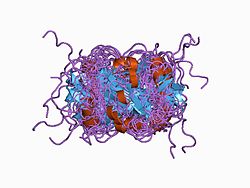




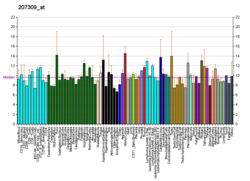
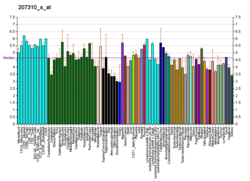
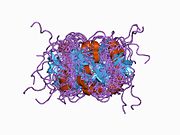

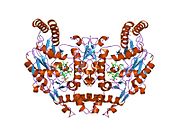
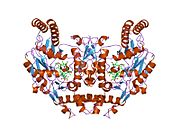
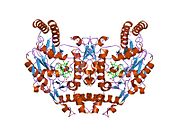
![1k2u: Structure of rat brain nNOS heme domain complexed with S-ethyl-N-[4-(trifluoromethyl)phenyl] isothiourea](https://upload.wikimedia.org/wikipedia/commons/thumb/e/e9/PDB_1k2u_EBI.jpg/180px-PDB_1k2u_EBI.jpg)

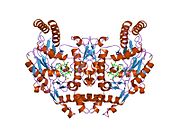
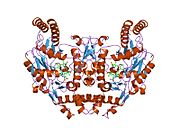
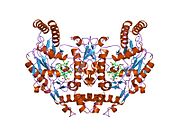
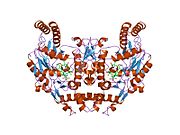

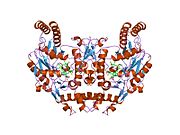
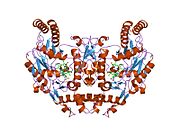
![1p6i: Rat neuronal NOS heme domain with (4S)-N-(4-amino-5-[aminoethyl]aminopentyl)-N'-nitroguanidine bound](https://upload.wikimedia.org/wikipedia/commons/thumb/5/51/PDB_1p6i_EBI.jpg/180px-PDB_1p6i_EBI.jpg)
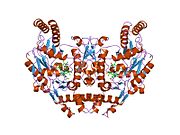

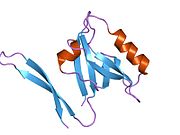


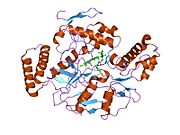
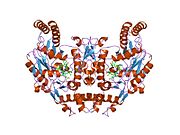

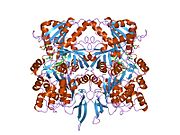

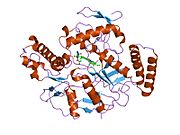
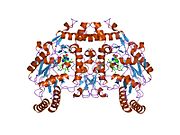

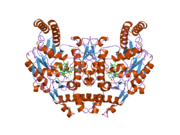
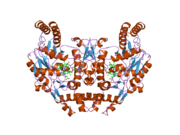
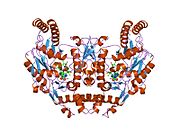
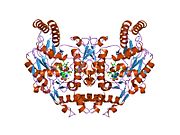




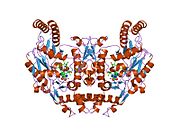
![2hx3: Rat nNOS heme domain complexed with (4S)-N-{4-Amino-5-[(2-aminoethyl)-hydroxyamino]-pentyl}-N'-nitroguanidine](https://upload.wikimedia.org/wikipedia/commons/thumb/a/a8/PDB_2hx3_EBI.jpg/180px-PDB_2hx3_EBI.jpg)
